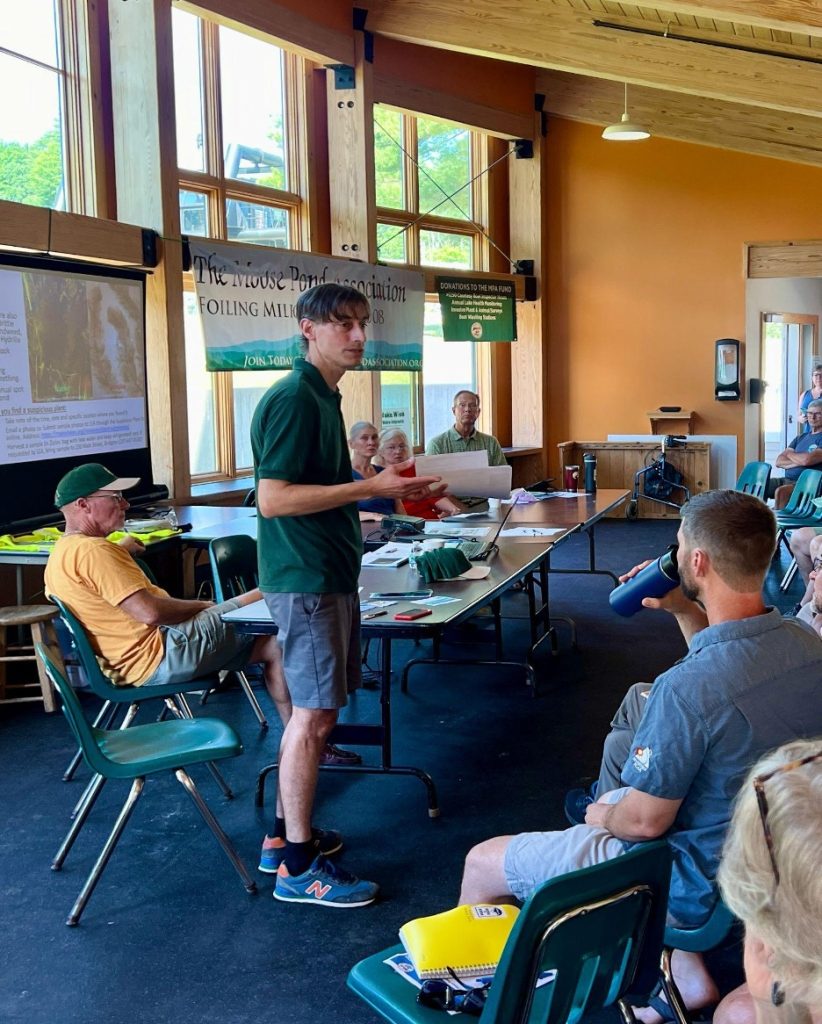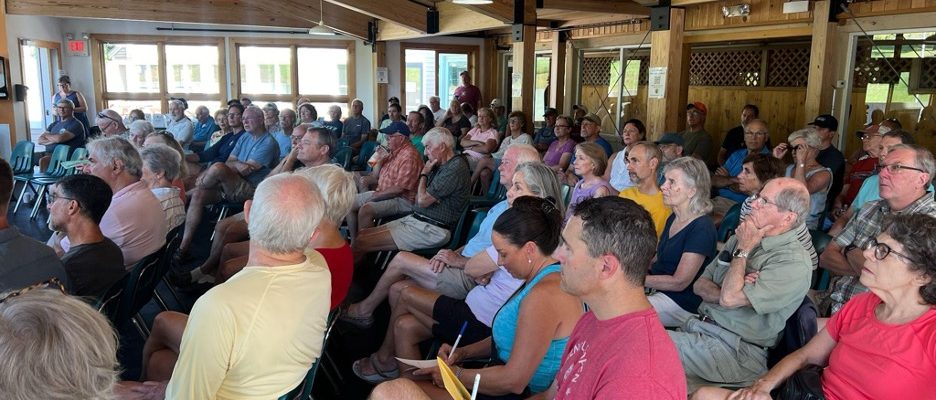Greetings Moose Pond Association Members–
I hope you all enjoyed your summer on the lake as much as I did. We had a lot of friends and family visit, and spent about as much time hiking on Pleasant Mountain as we did on the lake.
Every summer I’m lucky enough to be invited to speak at either a neighborhood association and/or road association meeting to provide MPA updates. To prepare for these meetings, I’ve drafted eight simple questions with answers to explain the Moose Pond Association. Here they are:
Understanding the Moose Pond Association in Eight Questions
by Chip Wendler • MPA President


1. What does the MPA do?
a. We make sure the health of the lake is regularly monitored
b. We pay for services to try to prevent invasive plants/animals from getting into the lake
c. We try to stop unhelpful nutrients from making their way into our pond
d. We advocate for courteous boating behavior
e. We try to educate local property owners to understand their role in keeping the lake healthy for all to enjoy for generations to come
f. We collect membership dues so we can pay for everything listed above
2. When was the MPA started?
a. The MPA was founded in 2008
b. A group of local residents including myself, Mark Patterson, and David Ehrman started it because we were concerned about the long-term health of Moose Pond. There’s a lot of data to suggest that lakes with active lake associations have better long-term outcomes than lakes without
c. David Ehrman was the first president, Mark Patterson was the second president and I am the third and current president of the MPA
3. Why was the MPA started? What were you concerned about at the time?
a. There are a growing number of lakes in Maine that are infested with invasive plants
b. There are a growing number of lakes in Maine that are covered with thick, green, slimy algae
c. Look no further than Arrowhead Lake (only 34 miles from Moose Pond) where the entire lake is infested with Milfoil. Local residents spend more than $100K a year just to clear pathways to their docks
d. You cannot swim or fish near the shoreline of Arrowhead Lake
e. Property prices are depressed. Some studies say that property prices fall >20% when a lake gets infested
f. There have been several outbreaks on Long Lake, and parts of Sebago are struggling
4. What gets monitored and how does that get done?
a. We pay LEA to sample Moose Pond’s water throughout the year to look for four key things
i. How much Phosphorus is in the lake as too much Phosphorus can lead to algae blooms
ii. Clarity, or how much sediment is in the water
iii. How much Chlorophyll is in the water as high Chlorophyll can be a leading indicator of a potential algae bloom
iv. Invasive plants and animals. LEA divers do spot checks once a summer at the most vulnerable (high traffic) areas of the lake
b. Two years ago the MPA started its Lake Section Captain initiative. This program slices up the lake’s shoreline into 17 sections. Two times per summer, volunteers (mostly MPA Board Members) scan “their section” of the lake to look for invasive plants/animals. They report any suspicious plants to LEA for closer inspection
5. What steps are you taking to prevent problems from occurring in Moose Pond? How are you making that happen?
a. Our first line of defense are the Courtesy Boat Inspectors (CBIs) you see at the Route 302 and Denmark boat launches
i. The CBIs are there to look for fragments of invasive plants and animals on boats and boat trailers to stop them before they enter Moose Pond
ii. Each year more than 1,500 inspections are performed and, in a normal year, dozens of plant fragments are discovered and removed
iii. Fortunately, most of these fragments are non-invasive, but a few years ago the inspection process prevented invasive Milfoil from entering the lake
iv. Donations to the MPA pay for the CBI program that is staffed/managed by LEA
b. The MPA maintains and pays for the Boat Washing Stations that are situated near the Route 302 and Denmark boat launches
i. We also try to educate boaters on the importance of washing down their boats, trailers, and bait wells before entering and after leaving Moose Pond
c. MPA promotes the LakeSmart program. This gives lakeside property owners access to a free property inspection to determine if their property optimally stops phosphorus laden runoff from making its way into Moose Pond
6. Why does the MPA care about courteous boating behavior?
a. It’s really all about big wakes near the shoreline. Big wakes:
i. Cause shoreline erosion, allowing more phosphorus to enter the lake
ii. Disturb loon nesting grounds
iii. Beat up peoples docks and boats
7. What is the MPA’s annual budget and what do you spend it on?
a. Our annual budget is about $54K per year
b. Our largest expenditures are:
i. The CBI program is the biggest part of our budget at $22K
ii. ~$8K each year to pay LEA for their testing/monitoring services
iii. ~$12K annually on member education and communication
iv. We save $10K per year to grow our emergency reserve fund. If Moose Pond does get infested, we can catch it early and try our best to prevent the spread of invasive plants or animals
8. What can you do to help?
a. Become a member by making an annual donation to the MPA. With more member donations we could:
i. Pay for more CBI hours
ii. Help fund projects to help keep phosphorus-laden runoff from entering the lake
iii. Build up the emergency reserve fund
b. Only 250 of the roughly 900 property owners around the lake are members – more would be much better
c. I would encourage you to have your property assessed by one of the LakeSmart inspectors to see if there are some easy fixes you could implement to stop unhelpful runoff from entering that lake
d. Join the MPA Facebook page so that you can stay informed

Chip Wendler, MPA President
Middle Basin Resident
30+ Years on the Lake
chipwendler@gmail.com

